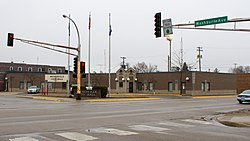2010 census
As of the census of 2010, there were 2,432 people, 1,065 households, and 635 families living in the city. The population density was 1,048.3 inhabitants per square mile (404.8/km2). There were 1,148 housing units at an average density of 494.8 units per square mile (191.0 units/km2). The racial makeup of the city was 97.0% White, 0.5% African American, 0.1% Native American, 0.4% Asian, 0.9% from other races, and 1.1% from two or more races. Hispanic or Latino of any race were 2.2% of the population.
There were 1,065 households, of which 26.9% had children under the age of 18 living with them, 46.9% were married couples living together, 7.1% had a female householder with no husband present, 5.6% had a male householder with no wife present, and 40.4% were non-families. 35.8% of all households were made up of individuals, and 20.4% had someone living alone who was 65 years of age or older. The average household size was 2.20 and the average family size was 2.83.
The median age in the city was 42.4 years. 22.1% of residents were under the age of 18; 6.9% were between the ages of 18 and 24; 23.6% were from 25 to 44; 21.9% were from 45 to 64; and 25.3% were 65 years of age or older. The gender makeup of the city was 47.7% male and 52.3% female.
2000 census
As of the census of 2000, there were 2,267 people, 934 households, and 594 families living in the city. The population density was 1,715.2 inhabitants per square mile (662.2/km2). There were 984 housing units at an average density of 744.5 units per square mile (287.5 units/km2). The racial makeup of the city was 98.81% White, 0.04% African American, 0.09% Native American, 0.31% Asian, 0.22% from other races, and 0.53% from two or more races. Hispanic or Latino of any race were 1.28% of the population.
There were 934 households, out of which 28.2% had children under the age of 18 living with them, 54.1% were married couples living together, 6.7% had a female householder with no husband present, and 36.4% were non-families. 32.9% of all households were made up of individuals, and 20.0% had someone living alone who was 65 years of age or older. The average household size was 2.32 and the average family size was 2.95.
In the city, the population was spread out, with 23.0% under the age of 18, 8.8% from 18 to 24, 24.2% from 25 to 44, 18.9% from 45 to 64, and 25.1% who were 65 years of age or older. The median age was 40. For every 100 females, there were 88.3 males. For every 100 females age 18 and over, there were 82.0 males.
The median income for a household in the city was $34,000, and the median income for a family was $42,500. Males had a median income of $30,978 versus $20,219 for females. The per capita income for the city was $17,246. About 4.5% of families and 8.1% of the population were below the poverty line, including 4.6% of those under age 18 and 15.2% of those age 65 or over.




